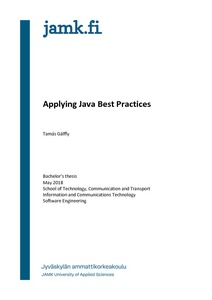Applying Java Best Practices
Galffy, Tamas (2018)
Galffy, Tamas
Jyväskylän ammattikorkeakoulu
2018
All rights reserved
Julkaisun pysyvä osoite on
https://urn.fi/URN:NBN:fi:amk-2018060112028
https://urn.fi/URN:NBN:fi:amk-2018060112028
Tiivistelmä
In larger projects, code must be easy to read, easy to understand and easy to maintain. Otherwise, this can become a major pain point on multiple levels; it can frustrate the individual, the team, and even the client. This provides a strong motivation to write clean code.
„Clean code” as a concept can be very vague and hard to define. Even if one succeeds in summarizing the concept, it may still be unclear how to achieve clean code, and how to continually use it. The concept needs to be established in the context of the project at hand, based on industry standard practices. Although many of these practices provide clear instructions, some of them can be difficult and impractical to manually enforce.
Since the project itself is confidential, an example project was introduced. This project contained many errors and multiple anti-patterns, that lent themselves very well to introducing and applying clean code practices.
To implement these practices, tools were introduced that continuously inspect the code and provide reports on code quality. If certain requirements are not met, the application’s build becomes unsuccessful, prompting the developer to fix the reported issues. Software engineering concepts were introduced and applied, to make the code more readable and maintainable.
These practices span from low-level principles concerning class design and package structure, up to high-level concepts such as module structure, testing, and code metrics.
At the end of the project, code metrics reports were created to objectively decide if these practices helped.
The results were positive, fixing many code smells, introducing a consistent coding style, testing, and better API design.
„Clean code” as a concept can be very vague and hard to define. Even if one succeeds in summarizing the concept, it may still be unclear how to achieve clean code, and how to continually use it. The concept needs to be established in the context of the project at hand, based on industry standard practices. Although many of these practices provide clear instructions, some of them can be difficult and impractical to manually enforce.
Since the project itself is confidential, an example project was introduced. This project contained many errors and multiple anti-patterns, that lent themselves very well to introducing and applying clean code practices.
To implement these practices, tools were introduced that continuously inspect the code and provide reports on code quality. If certain requirements are not met, the application’s build becomes unsuccessful, prompting the developer to fix the reported issues. Software engineering concepts were introduced and applied, to make the code more readable and maintainable.
These practices span from low-level principles concerning class design and package structure, up to high-level concepts such as module structure, testing, and code metrics.
At the end of the project, code metrics reports were created to objectively decide if these practices helped.
The results were positive, fixing many code smells, introducing a consistent coding style, testing, and better API design.
